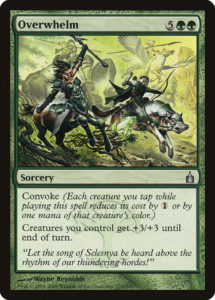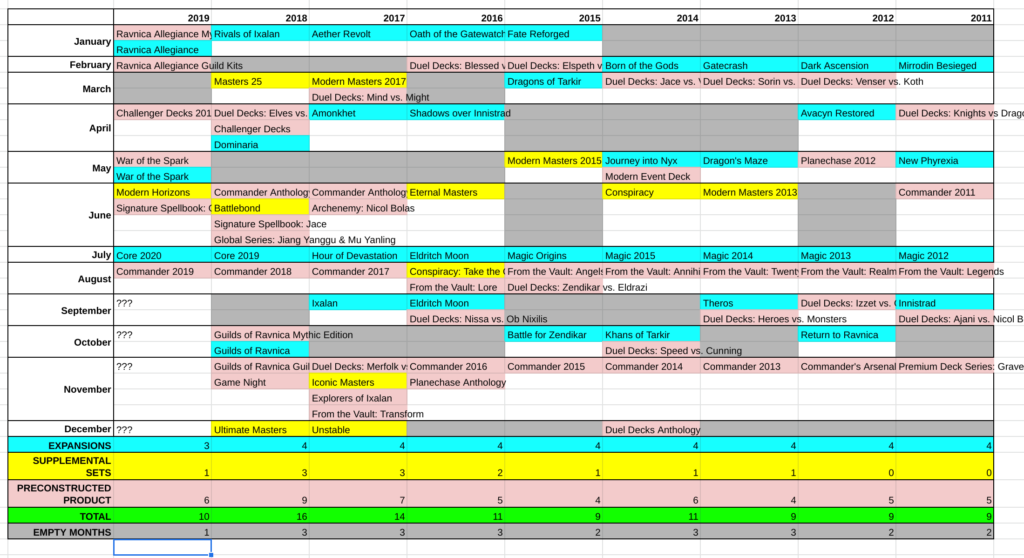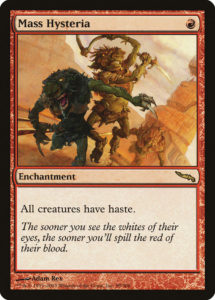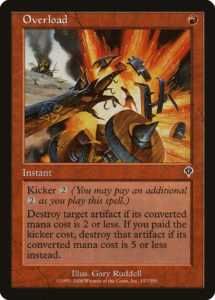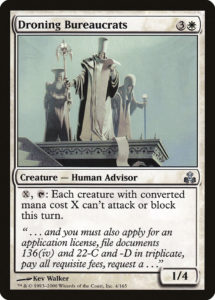Three years ago, Magic had its most jam-packed summer ever. Half of the year’s major products released in less than four months. Eternal Masters, Eldritch Moon, Conspiracy: Take the Crown, and Kaladesh all came out between June 10th and September 30th, with a From the Vault and Duel Deck thrown in for good measure.
During this period, each set’s release cascaded into the next’s spoiler season, leading to seemingly endless hyping. Player fatigue built over time. Conspiracy: Take the Crown suffered from having effectively only one week of relevance. We discussed these are problematic trends back in 2016. Now, they have returned.
This Week in Magic
Magic in 2019 is a quite different than it was in 2016. The Core Set is back, Masters sets and blocks are gone, Mythic Editions are in, and Magic Arena is helping make the game bigger than ever. That said, we’re in the midst of a summer that’s quite reminiscent of 2016. Look at this week: Modern Horizons released this past weekend (with two MagicFest in the books and another coming this weekend), Core 2020 spoiler season began yesterday (although we’d already seen a few Core 2020 Planeswalkers last week), and Mythic Championship III (the first Arena MC) is this coming weekend.
All three of these are presumably tailored to Magic’s more enfranchised crowds. Yes, the Core set is much more focused towards introductory play, but it’s still hugely relevant to Standard. And yet none of them bear any relationship to each other—the Mythic Championship will feature zero cards from Modern Horizons (because Modern is not and likely will not be on Arena for the foreseeable future) and Core 2020 (because it’s not out yet). That’s a lot to have going on in one week and competing for attention.
Furthermore, all of this is coming on the heels of War of the Spark, which released a mere six weeks ago. I’d wager a similar thing will happen to WAR as happened to Dragon’s Maze, Iconic Masters, and Conspiracy: Take the Crown—they were swiftly followed by other booster products which stole focus and dollars. That’s particularly disappointing for War of the Spark, since it’s not only a fun format, but also chock full of shiny Planeswalkers.
With all this in mind, I fired up Google Sheets again. It’d been three years, so it was high time to update that spreadsheet and see how the trends have gone. (Okay, technically I remade it, since I deleted the old one.) And well, see for yourself:
Note: I have excluded introductory-focused products like Planeswalker Decks, Intro Packs, and Deckbuilder’s Toolkits, as well as inexpensive products with no new content like Holiday Gift Boxes. Basically, I’ve included everything that introduces a bunch of new cards, has a variety of notable reprints, or commands a more than $20 price point. Planeswalker decks kind of cross this line (because they introduce multiple new cards), but given how unpushed they are and how few other news are included, I left them out (while I did include Global Series for being all new). If you’d like to count Planeswalker Decks, they started in Kaladesh (so add one preconstructed product for each major release since September 2016).
More is More
Oh. Oh my. That’s a lot more Magic than I would’ve guessed.
In 2016, I felt overwhelmed because Magic added a second supplemental set and there were three draftable sets in as many months.
2017 began with the third draftable set in a two month period, had the first month ever with four releases, and had three supplemental sets to 2016’s two.
2018 spaced out its sets a bit more evenly, but also had three supplemental sets and a month with four releases. It had almost twice as many preconstructed products (nine) as 2016 did (five).
In 2019, we’re once again in a two month period where three sets come out. We’ve got more Magic than ever before, with even more overlap than before. In 2016, I concluded that the small increase in products was more a scheduling issue than a quantity issue. In 2019, I’m not sure this remains correct. Yes, many of these products are geared towards underserved audiences (like Guild Kits towards more casual players and roleplayers, or Mythic Edition towards people with money and those who enjoy arbitrage) and other special products have become annual (like Commander). However, we might be past peak capacity for peoples’ attention and wallets.
Hype
Spoiler season is one of the most exciting times of the year to be a Magic player. It arrives just as you’ve played enough of the previous format. You’ve seen the changes to Constructed, and you’re ready for something new. You get to peek into the future to see what presents you will receive in a few short weeks. Then finally the day arrives where you get to play with your new toys and you dig into the format. Time passes, your enjoyment ebbs, and the next spoiler season comes around as the cycle begins anew.
This cycle breaks when spoilers arrive too soon. When there are few to no breaks between one season and the next, there is no ebb and flow of excitement. There is always something new to look forward to but no time to savor what you’ve just received. When everything matters all the time, with no tension and release, then nothing matters. By the time you get the new thing, it’s already obsolete.
Hype is a renewable but finite resource. Having periods of endless spoiler season (June-September ’16, November ’17-January ’18, or May-July ’19) makes it difficult to appreciate or even get excited for every product that comes out. Instead of being a lesson learned from 2016 and Conspiracy 2’s lackluster release, it seems spoiler-saturation is becoming an annual tradition.
What to Play?
There’s a major issue with concurrent, competing product releases at the LGS level—getting people to agree on what to play. In December 2017, players had the choice between the newly-released Iconic Masters, the newly-released Unstable, and Ixalan. When normally they’d have one or two choices of what to play, they had three. Ixalan was an unpopular Limited format, Iconic Masters was expensive (especially with its value per pack being so low for a Masters set), and Unstable was cool but wacky (which narrowed its appeal). As a consequence, stores had two choices: try to get their players to agree on a format (which often led to a large portion of players not playing what they wanted to) or run release events for the new sets followed by Ixalan events (which was the cheapest format for players, was playable at the PPTQ level, and had black bordered cards you could put in your decks).
Today, we are running into the same issue with War of the Spark, Modern Horizons, and Core 2020. Enfranchised drafters have essentially been told that core set Limited is designed first and foremost for introductory play, then for Constructed players, with Limited being at most a tertiary concern. Core sets are intended as an opt-in product. Last summer some stores in NYC opted out, offering the incredibly popular Dominaria instead of or in addition to Core 2019 drafts. It’s going to be harder to get people on board with something other than Core 2020 when there are three products competing for attention instead of two.
I am neither a businessperson nor a member of Wizards of the Coast. I couldn’t begin to tell them how to run their business. But as a frequent and frequently happy consumer of Magic, I wish Modern Horizons had released after Core 2020 instead of before. I’m still enjoying War of the Spark, but it’s been prematurely retired by virtue of two new sets piling atop it. I’m excited to play Modern Horizons, but because it’s only the new hotness for two weeks, I won’t be able to play as much of it as I’d like, either.
This summer, I will spend less money on Magic than I want to spend. I’ll do so because the events I want to play aren’t happening, and they aren’t happening because they’re competing with Magic’s other offerings. Once Core 2020 releases, I might not spend any money on Magic until the unnamed fall expansion arrives. I am very quickly going from having too many things to play but not enough time to do so, to having two months of Core 2020 and Commander 2019, two products I have ample time for but no interest in.
I’m far from Magic’s typical consumer. Heck, enfranchised players like me only constitute a tiny portion of Magic’s playerbase and command a far smaller share of its revenue than we believe. But I’d bet I’m far from alone in having these complaints. I recognize that I am the type of player who benefits heavily from Magic’s biggest and most frequent releases, while long-underserved players are the biggest beneficiaries of new products like Battlebond, Explorers of Ixalan, Challenger Decks, and Game Night. Nevertheless, I am concerned that issues from three years ago, issues which Magic was aware of when it pushed back Unstable’s release to keep it from getting subsumed by Ixalan (and yet scheduled it to subsume the doomed Iconic Masters), have not only returned, but never actually been addressed.
I worry that the need for constant hype and newness is perhaps a core issue for everything that Magic is today. I see it when I look at the constantly changing shape of professional play and the potpourri of tournaments that we’re expected to care about without really knowing why. I see in the flirtation with three-week-long spoiler seasons how audiences are being tested to see how long the hype can last. And in the Mythic Edition, I see a product doomed to flawed success because you’d be a fool not to spend $250 on $700 worth of cards, regardless of whether the intended audience for it actually exists.
I love Magic. I continue to believe it is the greatest game on Earth. It is nevertheless strange that Magic itself seems to be getting in the way of my ability to not only play Magic, but to spend money on it. Three years ago, I was optimistic that we were witnessing a flawed but educational experiment. Today, I fear that the either the wrong conclusions have been drawn or that something is fundamentally wrong with me (and seemingly everyone I know) for not being able to ride the hype train all year round. Only time will tell.
And, as always, thanks for reading.
—Zachary Barash is a New York City-based game designer and the commissioner of Team Draft League. He designs for Kingdom Death: Monster, has a Game Design MFA from the NYU Game Center, and does freelance game design. When the stars align, he streams Magic.
His favorite card of the month is Arcum’s Astrolabe. It’s a twist on Prophetic Prism, which is already his favorite card of all time. However, instead of being a simple, “now you have all the colors,” Acrum makes you work harder. If you can jump through the hoop of feeding it a single snow mana, it will not only filter your colors into any color of snow mana, it’ll also do so at a massive 50% discount.

